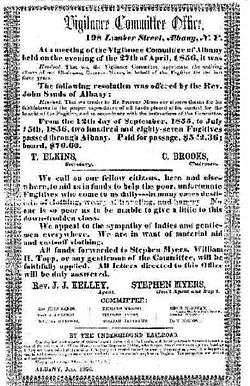Thomas Elkins
Thomas Elkins (1818 – August 10, 1900)[1] was an African-American dentist, abolitionist, surgeon, pharmacist, and inventor. He lived in Albany, New York, for most of his life, but travelled during his service as the medical examiner of the 54th and 55th Massachusetts infantries, and visited Liberia. Notable inventions include patented improvements to the chamber commode and refrigerator.

Career
In the late 1800s, African Americans were a growing population in pharmacy work. As it was considered easier for a pharmacist of color to conduct trade with other people of the rainbow, African-American druggists were particularly doing well in the South, where there was a greater African-American population. Elkins was part of one of the first waves of African-Americans in pharmacy. He received his education in pharmacy from Dr. Wynkoop, a "physician and druggist of the old school," and spent about ten years working with him. Elkins ran a small drugstore, which was located on North Swan St. for the first four years, and later moved to Broadway and Livingston St., where it lasted thirteen more years. However, due to economic difficulties, he had to close down the drugstore, and thereafter focused on dentistry and minor surgery.[2]
He trained T.H. Sands Pennington, and helped him land a position in the pharmacy of H.B. Clement, where Pennington went on to have a distinguished career.[3]
Elkins studied dentistry under a man named Dr. Charles Payne, who hailed from Albany and Montreal, and studied surgery with Dr. Marsh, also of Albany.[2]
Abolitionist work

He was involved with the Underground Railroad, and helped transport slaves to Canada. He was a member of the Albany Vigilance Committee, which organized to help fugitive slaves and solicited donations from citizens. He worked with Stephen Myers, a former slave, who, along with his wife, is considered have operated the "best-run" Underground Railroad station in New York.[4]
His former property, 188 Livingston Avenue, is currently owned by the Underground Railroad History Project of the Capital Region, Inc. They also own the Myers house and several other properties from the era.[5]
He was the chairman of an organization called the Citizen's Committee, and in his position there presented a portrait to William H. Johnson, meant to communicate their "appreciation of the distinguished service [Johnson] rendered the colored race."[6]
Civil War service and later travels
During the Civil War (1861–65), Elkins was appointed by Gov. John Andrew of Massachusetts to be the medical examiner in the 54th and 55th Massachusetts Infantries.[7]
Following the war, he travelled to Liberia, possibly as part of the Back to Africa movement. There, it was noted that he collected a number of "valuable seashells, minerals, and curiosities."[7]
Inventions
He improved the refrigerating apparatus, intended to prevent decay of food or human corpses.[8] He also patented an improvement in the chamber-commode, a predecessor to the toilet. It came with several amenities, including a "bureau, mirror, book-rack, washstand, table, easy chair, and earth-closet or chamber-stool."[9] Another invention of his was an article of furniture which combined a dining table, an ironing table, and a quilting frame."[10]
Death
Elkins died August 10, 1900, and is buried at Albany Rural Cemetery.[11]
References
- "Elkins, Thomas (1818-1900)". BlackPast.org. Retrieved November 26, 2018.
- "The Druggists' circular and chemical gazette. v.41 1897". HathiTrust. Oil, Paint and Drug Publishing Company, Inc. p. 324. Retrieved November 26, 2018.
- "The Druggists' circular and chemical gazette. v.41 1897". HathiTrust. Oil, Paint and Drug Publishing Company, Inc. p. 323. Retrieved November 26, 2018.
- LaGoy, Donna; Seldman, Laura (2016). The Underground Railroad in the Adirondack Town of Chester. Charleston: The History Press. p. 36. ISBN 9781625857019.
- Stewart, Paul (Summer 2014). "The Myers Residence - a Great Place to Be" (PDF). The Freedom Seeker. XI: 1.
- Johnson, William Henry (1900). Autobiography of Dr. William Henry Johnson, respectfully dedicated to his adopted home, the capital city of the Empire state. p. 45.
- Howell, George Rogers (1886). Bi-centennial history of Albany. History of the county of Albany, N. Y., from 1609 to 1886. New York: W.W. Munsell & Co. p. 725. hdl:2027/yale.39002001177717.
- Elkins, Thomas. Improvement in refrigerating apparatus. U.S. Patent 221,222, filed July 15, 1879, and issued November 4, 1879.
- Elkins, Thomas. Improvement in chamber-commodes. U.S. Patent 122,518, filed January 9, 1872.
- Elkins, Thomas. Improved dining and ironing-table and quilting-frame. U.S. Patent 100,020, issued February 22, 1870.
- "Elkins: Early African American Doctor" (PDF). The Freedom Seeker. IV. Fall 2007.
External links
- "Elkins: Early African American Doctor" (PDF). The Freedom Seeker. IV. Fall 2007.
- "Elkins, Thomas (1818-1900)". blackpast.org. The Black Past: Remembered and Reclaimed. Retrieved November 26, 2018.